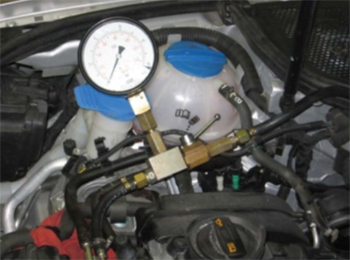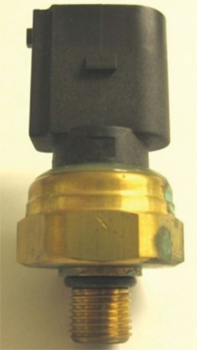 Affected Vehicles: 2005-’08 A4, A4 Cabriolet, A6, A8, Q7, RS4, S6, S8 and TT; all VINs; 3.2V6, 3.6 V6, 4.2 V8 and 5.2 V10 FSI engines.
Affected Vehicles: 2005-’08 A4, A4 Cabriolet, A6, A8, Q7, RS4, S6, S8 and TT; all VINs; 3.2V6, 3.6 V6, 4.2 V8 and 5.2 V10 FSI engines.
Condition
The MIL is on with one or more of the following DTCs stored in the ECM data memory:
– P310B (low-pressure fuel system regulation, fuel pressure outside tolerance)
– P129F or P008B (low-pressure fuel system, pressure too high)
– P129E or P008A (low-pressure fuel system, pressure too low)
– P2540 (low-pressure fuel system, pressure out of range)
– P0087 (rail fuel pressure system, pressure too low)
Due to fuel intrusion into the low-pressure system fuel pressure sensor (G410), a false signal may be sent to the controller, resulting in a reading that is out of tolerance. 
Comparing Measure Value Block (MVB) 103 with 106 is not an accurate method to diagnose low-side fuel pressure sensor G410.
In order to diagnose G410 accurately, use a mechanical gauge and compare results with the low-side fuel pressure Actual Value in MVB 103.
Service
1. Verify the customer did not run out of fuel at the time the DTCs were stored.
Tip: P310B and/or P129E/P008A may be accompanied by P1250. If so, it is likely the faults occurred due to a low fuel level and not a malfunction of the G410 pressure sensor.
2. Follow indication of GFF for applicable DTCs.
3. To check the low-side fuel pressure sensor G410, measure the fuel pressure with a mechanical gauge using the following method:
a. Start the engine and allow it to idle for at least one minute.
b. Stop the engine.
c. Keep the ignition on.
d. Measure actual low-side fuel pressure via the mechanical gauge (VAG 1318) on the low-pressure supply line in the engine compartment (see Figure 1).
4. Add 1 bar to the value obtained from the mechanical gauge to calculate the adjusted gauge measurement value.
5. Compare the adjusted gauge measurement value to the Actual Value stored in MVB 103 field 1.
6. If the MVB 103 field 1 value deviates more than +/-1.0 bar from the adjusted gauge measurement value, then the DTC was likely triggered by a faulty G410 low-side fuel pressure sensor. In this case, document the adjusted gauge measurement value and MVB value on the repair order and perform the sensor replacement procedure below.
Sensor Replacement Procedure
1. Replace the G410 low-side fuel pressure sensor (Figure 2).
2. Clear any DTCs and verify that the problem was eliminated.
3. Run Basic Settings 103 to adapt the system.
4. Do not replace the high-pressure fuel pump, electrical fuel pump, fuel pump control module or fuel filter unless the problem persists and further diagnosis indicates a malfunction of any of these components.
Required Parts and Tools
– Thrust sensor, P/N 06E 906 051 K
– Thrust sensor for 3.6 V6 motor (engine code BHK), P/N 03C 906 051 A
Courtesy of ALLDATA.













